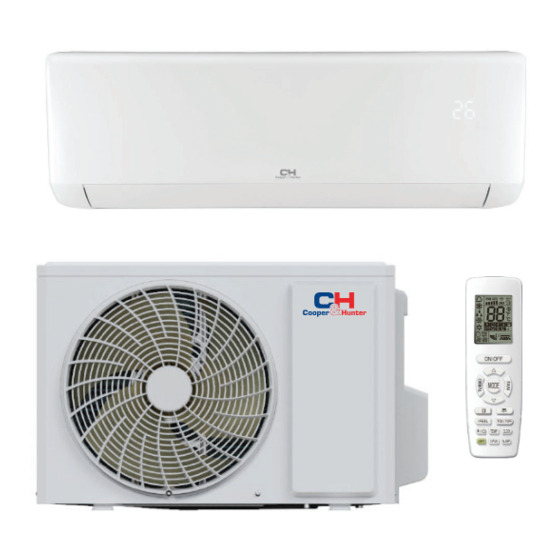
Summarization of Contents
Exception Clauses
Manufacturer's Liability Limitations
Manufacturer's responsibilities for product misuse, alteration, gas damage, transport damage, improper operation, third-party parts, or force majeure.
Safety Precautions
Installation Safety
Guidelines for safe installation, including qualified professionals, wiring regulations, grounding, circuit breakers, and power supply checks.
Operation and Maintenance Safety
Safe Operation Practices
Safe usage by children, cleaning precautions, cord replacement, socket usage, water avoidance, and self-repair prohibition.
Installation and Relocation Notice
Safety Precautions for Installation
Critical safety measures during installation and relocation, focusing on refrigerant circuit integrity, correct refrigerant usage, and safe handling.
Tools for Installation
Lists essential tools like level meter, screwdrivers, drills, pipe expanders, wrenches, and vacuum pumps for unit installation.
Installation Location Selection
Electrical Connection Requirements
Proper wiring, qualified circuit breaker with magnet/heating buckles, and correct wire capacity for overload/short-circuit protection.
Grounding Requirements
Ensure proper grounding by a professional, use yellow-green wire for grounding, comply with national safety regulations, and ensure accessibility.
Cleaning and Maintenance
Filter Cleaning
Instructions for opening the panel, removing, cleaning, and installing the air filter. Emphasizes frequency and avoiding damage.
Pre-Season Checks
Guide for checking air inlets/outlets, switches, plugs, sockets, filters, mounting brackets, and drainage pipes before seasonal use.
Error Codes
Lists common error codes (E1, E5, H3, etc.) and their troubleshooting steps, advising professional service if needed.
Maintenance Troubleshooting
General Phenomenon Analysis
Troubleshooting common issues like no remote signal, no air, strange noises, unusual odors, and inefficient cooling/heating.
Air Conditioner Parts Identification
Indoor Unit Components
Identifies key parts of the indoor unit including air inlet, panel, filter, aux button, louvers, and air outlet.
Display Indicators
Explains the temperature and power indicators on the indoor unit's display panel.
Remote Control Operation
Remote Control Buttons Overview
Introduces main buttons on the remote control like ON/OFF, MODE, FAN, TURBO, TEMP, and SLEEP.
Display Screen Icons
Explains various icons displayed on the remote control screen related to fan speed, temperature, operation modes, and special functions.
Test and Operation
Post-Installation Checks
Verifies secure installation, refrigerant leakage, pipe insulation, water drainage, voltage compliance, wiring, grounding, and air obstruction.
Test Operation Procedure
Client approval, important notes briefing, powering on, selecting modes (AUTO, COOL, DRY, FAN, HEAT), and ambient temperature considerations.
Outdoor Unit Identification
Outdoor Unit Parts
Identifies the air inlet and air outlet of the outdoor unit.
Installation and Relocation Guidelines
Installation Safety Precautions
Critical safety measures during installation and relocation, focusing on refrigerant circuit integrity, correct refrigerant usage, and safe handling.
Installation Tools List
Lists necessary tools for installation, including measuring tools, fastening tools, drilling equipment, and diagnostic devices.
Testing and Operation Procedures
Vacuum Pump Usage
Step-by-step guide on using a vacuum pump to evacuate the system, checking pressure levels, and detecting leaks.
Leakage Detection Methods
Procedures for detecting refrigerant leaks using a detector or soap water, ensuring system integrity.
Test Operation
Client approval, briefing, powering on, mode selection, and ambient temperature checks for normal operation.
Connection Pipe Configuration
Standard Pipe Lengths
Details standard, minimum, and maximum lengths for connection pipes based on cooling capacity.
Refrigerant Charging Calculation
Provides methods for calculating additional refrigerant oil and charge amount based on extended pipe lengths.
Pipe Expanding Method
Step-by-step instructions for cutting, deburring, insulating, and expanding pipes to prevent refrigerant leakage.
Specialist's Manual
Flammable Refrigerant Installation Checks
Specific checks for installations using flammable refrigerants, including charge size, ventilation, secondary circuits, and markings.
Electrical Component Repair
Safety procedures for repairing electrical components, including initial checks, capacitor discharge, and ensuring no live parts are exposed.
Refrigerant Handling Procedures
Guidelines for recovering, labelling, and transferring refrigerants safely, including cylinder preparation and equipment maintenance.

















Need help?
Do you have a question about the PRIMA PLUS CH-S12XN7 and is the answer not in the manual?
Questions and answers